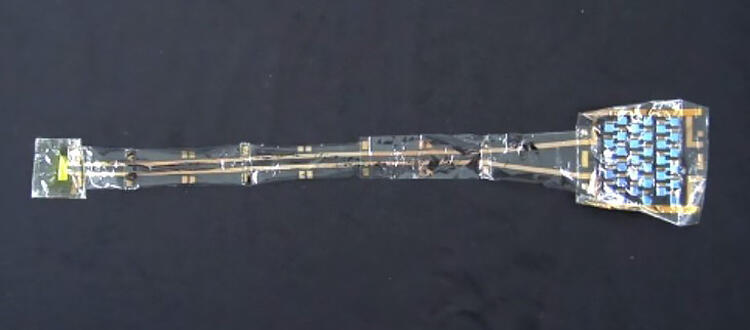In order to fabricate a next-generation wearable device that can be attached to the body, it is important to connect the circuitry neatly. The collaborative research group comprising Kenjiro Fukuda, full-time researcher with RIKEN, Takao Someya, chief researcher with Cluster for Pioneering Research, and Prof. Shinjiro Umezu, Professor at Waseda University School of Creative Science and Engineering, succeeded in developing a technology for achieving direct electrical connection of gold deposited on a polymer film without using an adhesive. The study was published in an online version of Science Advances.

Provided by RIKEN
In recent years, the performance and thinning of sensors and electrodes have progressed to achieve the practical application of next-generation wearable devices that can be attached to the skin and clothes. These devices can be combined with IoT to monitor health without being consciously aware they are being worn. To realize an ultra-thin device, wiring and mounting technologies that integrate multiple electronic components are required. In particular, it is essential for the device to have low rigidity and high flexibility that does not impair the conductivity of the metal, and low temperature processing capabilities to prevent damage to the device. However, the rigidity of the joint increases due to increased thickness in a conventional wiring method because it uses a conductive adhesive and heating/pressurizing process.
The research group discovered that metal bonds were formed by irradiating a gold electrode, deposited on a 2 micrometer-thick polymer material parylene substrate, with water-vapor plasma and bringing the gold electrodes into contact with each other. This new bonding method was named water vapor plasma-assisted bonding (WVPAB). Researcher Fukuda said, "Because water vapor plasma originally reduces the surface, we wondered if it would be possible to make a bond without oxidizing the metal surface, and we were able to find the optimum conditions through repeating the experiment." WVPAB is a very simple method in which the substrate is placed in a chamber, exposed to steam plasma at a low vacuum of about 10 pascals, then taken out, and the gold electrodes are attached. A comparison of the flexibility of the joint between the thin film sample bonded by WVPAB and that bonded by the conventional anisotropic conducting film (ACF) showed that the minimum radius of curvature of the ACF junction was greater than or equal to 1 mm, while that of the WVPAB junction was less than 0.5 millimeter. In addition, the change in electrical resistance was less even after the 50% elongation/compression test and bending test, which was repeated 10,000 times. Furthermore, the decrease in electrical resistance 555 hours later was only 9% even after the heating test at 100 °C.
The group also demonstrated the application of ultra-thin flexible electronics to integrated devices. They succeeded in interconnecting ultra-thin organic solar cells, with a thickness of about 3 micrometers, ultra-thin organic LEDs, and multiple ultra-thin wiring with WVPAB. It was confirmed that the element and the substrate were not damaged by WVPAB, and the solar cell was actually irradiated with light, and the organic LED emitted light with the generated solar power. The group said that, in this experiment, they succeeded in connecting the gold wiring by WVPAB, but in the future, they will also work on joining other metals such as silver, copper, platinum, and aluminum.
This article has been translated by JST with permission from The Science News Ltd.(https://sci-news.co.jp/). Unauthorized reproduction of the article and photographs is prohibited.




